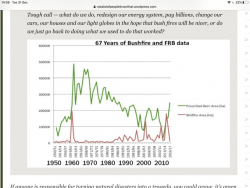Sorry but the link from Moody is the ABC fact checking unit.They do not give all the facts.Only WA has ever done prescribed burning at the recommended levels which in virtually every inquiry has been 5-8% of vulnerable land.After 1961 WA did HRBs at 8% and the result was a massive decline in fire intensity and area burnt.
In the examples posted by p..and..t being the current fires and 2009 no where near enough HRBs had been done so how you could deduce that the HRBs had been no help is of course nonsense.
During the 2009 there was as well inadequate fire breaks and inacessable fire trails.
After 2009 Victoria set a target of 5% HRBs which was not met so they decreased the target to 3% but after a couple of years no longer published a target.
In NSW HRBs in National Parks have been less than 2% for years.As well inadequate fire breaks and blocked fire trails.
You need the who;e suite of hazard reduction to be successful in reducing fire intensity and spread.
Here is another ABC link with the predictions from David Packham,who studied fires for most of his life,said that conditions in 2017 were worse than 2009.
Veteran bushfire scientist David Packham fears Victoria is more vulnerable to a bushfire tragedy than ever before, despite what the state learnt in the years following Black Saturday.

www.abc.net.au
Back to the WA experience.When HRBs were as required-less area burnt.When it falls increased area burnt.Real world experience.
View attachment 204723.















